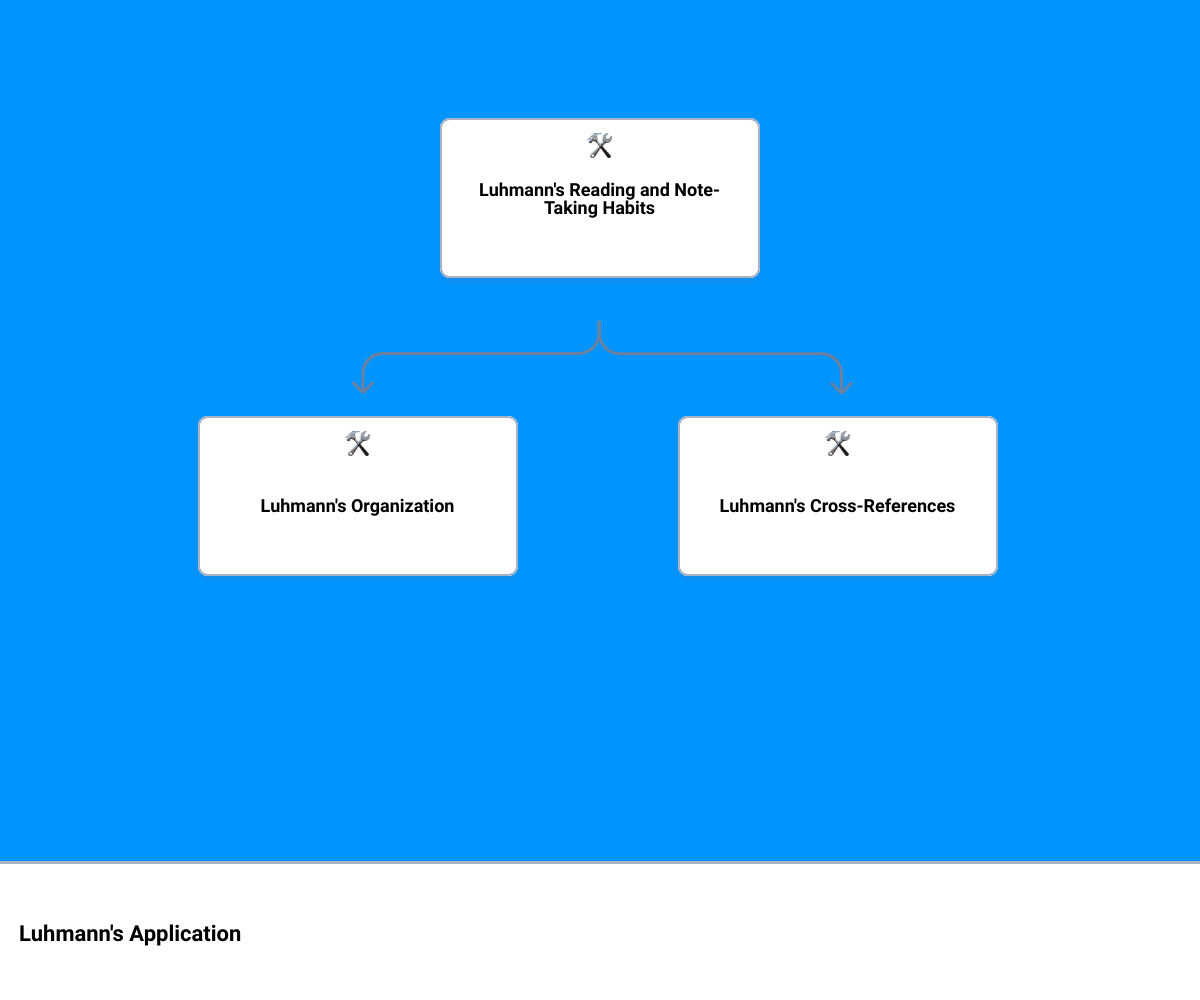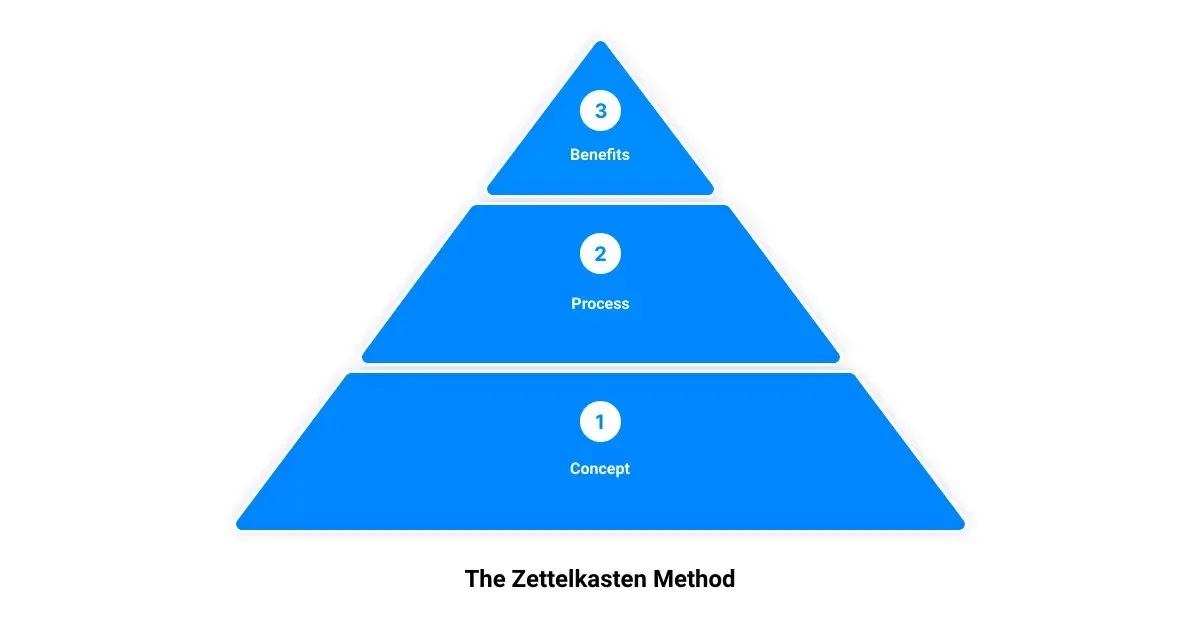Introduction: Who is Niklas Luhmann and What is His Note-Taking System?
Welcome to the world of Niklas Luhmann, the mastermind behind a revolutionary note-taking system that continues to influence knowledge organization to date. A prominent sociologist and philosopher, Luhmann left behind a remarkable legacy, not just in his academic contributions, but also in the ingenious note-taking system he devised: the Zettelkasten method, or the "slip box" method.
Born in the 20th century, Luhmann was known for his prolific writing, having published around 60 books and hundreds of articles. One might wonder, what was the secret to Luhmann's productivity? The answer lies in his unique approach to gathering, organizing, and connecting pieces of information, known as the Zettelkasten Method.
The Zettelkasten Method is a strategic note-taking system that involves creating and connecting small notes or "Zettels" that each contain a single idea or piece of information. This approach enables the formation of an interconnected web of ideas, making it easier to track the development of thoughts over time. The system emphasizes atomicity, breaking down information into its smallest possible components, and facilitating the linking of individual pieces of information together.
Intriguing, isn't it? As lifelong learners, we are constantly looking for effective methods to organize and retain information. And if you're on the journey of learning Mandarin, including Chinese characters, understanding and applying the Zettelkasten method could be a game-changer.
So, let's embark on this knowledge adventure and learn how Niklas Luhmann's ingenious note-taking system can help us master the art of knowledge organization, especially in the context of language learning.
The Zettelkasten Method: A Deep Dive into Luhmann's Note-Taking System
Immerse yourself in the sea of knowledge and swim with the tide of understanding with the help of the Zettelkasten method. This system, pioneered by the renowned sociologist and philosopher Niklas Luhmann, is a powerful tool for learning, especially when it comes to language mastery like Mandarin. Let's dive deeper into the underlying concept, the process, and the benefits of this method.
The Concept of Zettelkasten: Understanding the 'Slip Box' Method
The term 'Zettelkasten' is German for 'slip box'. It's a system of note-taking where each piece of information or idea is written on a 'Zettel' - a slip or note of paper. These slips are then organized in a 'Kasten' or box. Each note is numbered, categorized, and linked to other related notes, creating a web of interconnected knowledge. The beauty of the Zettelkasten method lies in its visual nature. It allows you to see the relationship between ideas and follow the flow of thought as it develops over time.
The Process: How to Use the Zettelkasten Method for Note-Taking
Incorporating the Zettelkasten method into your note-taking routine is rather simple. Here are four steps to get you started:
- Capture ideas quickly: Jot down your thoughts or important information from literary sources immediately. This ensures you don't forget valuable insights or lose track of useful sources.
- Break down information: Embrace the concept of atomicity. Break down information into its smallest possible components. This makes it easier to link individual pieces of information together and build a comprehensive understanding of a particular topic.
- Interlink your notes: Each note should be linked to other relevant notes, creating a network of interconnected ideas. This makes it easier to build on existing knowledge and discover new connections.
- Review your notes: Regularly review your notes to reinforce your memory, uncover new insights, and keep your system organized.
The Benefits: Why the Zettelkasten Method is Effective for Knowledge Organization
The Zettelkasten method has several benefits that make it a powerful tool for knowledge organization. Firstly, it allows for more efficient recall of information. With the visual web of interconnected ideas, it becomes easier to retrieve and connect ideas, leading to a robust understanding of the topic at hand. This is especially beneficial in language learning, where understanding the connections between characters, words, and meanings is critical.
The Zettelkasten method also incorporates the principles of spaced repetition, which is scientifically proven to enhance memory retention. It enables you to encode what you’re learning, making the content meaningful to your mind and less likely to be forgotten.
Lastly, the Zettelkasten method allows for continuous learning and expansion of knowledge. As you add more notes and links, your understanding deepens and evolves over time. This continuous learning and growth make the Zettelkasten method an enduring and effective strategy for mastering the art of knowledge organization.
In the next section, we'll delve into the historical context of the Zettelkasten method and how it has influenced modern note-taking systems.
The Historical Context: The Evolution of the Zettelkasten Method
Just as the world's greatest inventions have a rich history, so does the Zettelkasten method. Let's travel back in time to uncover the origins of this ingenious note-taking system, the influencers who brought it to the limelight, and the impact it has had on modern knowledge management systems.
The Origins: The Use of Index Cards for Note-Taking in the 17th Century
The roots of the Zettelkasten method can be traced back to the 17th century. Long before the digital age, scholars were already exploring ways to efficiently manage knowledge. One such scholar was Conrad Gessner, who, in the commonplace book tradition, innovated a system where individual notes could be rearranged at any time. Gessner recommended gluing slips onto bound sheets, which was a significant step from commonplace books to index cards for scholarly information management.
The Influencers: Notable Users of the Zettelkasten Method
The Zettelkasten method wasn't just a fleeting trend but a system embraced by influential thinkers. Sociologist and philosopher Niklas Luhmann is the most notable figure associated with the Zettelkasten method. He credited his extensive productivity—comprising more than 70 books and nearly 400 scholarly articles—to his personalized Zettelkasten system.
But it's not just academics who found value in this system. Bestselling author Ryan Holiday, known for his works "The Obstacle is the Way" and "Ego is the Enemy," also used the Zettelkasten system to organize his research and ideas. For Holiday, the Zettelkasten method was instrumental in creating a "personal library" of knowledge that he could easily access and draw upon in his writing.
The Impact: How the Zettelkasten Method Influenced Hypertext Systems and Wikis
The Zettelkasten method didn't just stay confined to index cards and physical boxes—it evolved and impacted the digital world. In the 1980s, the card file metaphor inspired the interface of some hypertextual personal knowledge base software applications such as NoteCards. Fast forward to the 1990s, it was the underlying inspiration behind the invention of wikis. These digital platforms embody the core principles of the Zettelkasten method: atomicity of information, linking of related ideas, and a visual representation of interconnected knowledge.
In essence, the Zettelkasten method isn't just a note-taking technique; it's a timeless system for personal knowledge management that has transcended centuries and influenced modern knowledge organization systems. Its historical context provides a deeper understanding and appreciation for this method that continues to be relevant in our digital age.

Luhmann's Application: How Niklas Luhmann Used the Zettelkasten Method
As we delve deeper into the Zettelkasten system, it's crucial to examine the method's biggest proponent, Niklas Luhmann. His application of the Zettelkasten system was instrumental in his prolific academic output.
Luhmann's Reading and Note-Taking Habits: The Role of Writing in Thinking
Luhmann had a unique approach to reading and note-taking. He was highly selective in his reading, focusing on texts that offered potential connections to his existing knowledge base. Luhmann saw the act of writing as integral to thinking, stating, "One cannot think without writing."
He rarely read a text twice, yet he was known for his impressive ability to recall and connect information. Whenever he encountered something noteworthy or had a thought about what he read, he made a note. Instead of copying ideas verbatim, he transitioned ideas from one context to another, much like a translation. This process of rewriting what was already written helped shift his attention towards patterns, categories, and underlying assumptions in the text.
Luhmann's Organization: How He Collected and Numbered His Notes
Rather than organizing his notes by topic, Luhmann used an abstract method of assigning fixed numbers to each note. These numbers held no inherent meaning, serving only to permanently identify each note. If a new note was directly relevant to an existing one, it was added immediately behind the previous note and assigned a consecutive or derivative number. This system allowed him to branch into as many strings of thought as he liked, creating a network of notes that could easily connect and reference each other.
This unique numbering system enabled Luhmann to add the same note to different contexts, and it allowed for the development of topics from the bottom up. Luhmann's collection of notes became much more than the sum of its parts, transforming into his idea generator, productivity engine, and dialogue partner.
Luhmann's Cross-References: The Four Types Used in His Zettelkasten
Luhmann's system of cross-referencing was central to the effectiveness of his Zettelkasten. Each note was just an element in a network of references and back references within the system. He used keywords to add the number of one or two notes next to them in the index, thus providing a way to easily retrieve and connect notes.
He also developed new categories of notes, realizing that an idea's value was determined by its context, which wasn't necessarily the context it was taken from. This led to a thoughtful consideration of how one idea could relate and contribute to different contexts.
In essence, Luhmann's application of the Zettelkasten method showcases the importance of active thinking in the reading and note-taking process, the significance of an effective note organization system, and the power of cross-referencing in creating a network of knowledge. His practices provide valuable insights for lifelong learners, particularly those mastering a complex language like Mandarin.

The Zettelkasten Method in the Digital Age: Physical vs. Digital Versions
In the age of digital transformation, traditional systems, including that of Niklas Luhmann's Zettelkasten method, are being reimagined for a digital landscape. This shift from physical to digital is not merely a matter of convenience but opens up a world of possibilities for improved efficiency and functionality.
The Transition: From Physical Index Cards to Digital Note-Taking
The original Zettelkasten system, as used by Luhmann, relied on physical index cards stored in a box. Each card held a unique piece of information, and the relationship between these cards was established through a system of cross-referencing.
As technology progressed, so did the methods of note-taking. Digital platforms have introduced new ways to implement the Zettelkasten method. Today, several digital tools, such as Obsidian, have been designed to replicate the Zettelkasten system, providing a digital platform for creating, organizing, and linking notes.
The Advantages and Limitations: Comparing Physical and Digital Zettelkasten Systems
Both physical and digital versions of the Zettelkasten method have their merits. The physical approach has an inherent spatial limitation, which can promote brevity and concise expression of ideas. However, it can also be cumbersome to manage and search through, especially with a growing number of notes.
On the other hand, digital Zettelkasten systems offer a high degree of flexibility and scalability. There's practically no limit to the number of notes you can create and store. Furthermore, digital tools make it easier to search for specific notes, create links between them, and even visualize the network of ideas. However, some may argue that the tangibility and simplicity of physical notes can help cement ideas more effectively in one's memory.
The Application: How Traverse Uses the Zettelkasten Method for Learning Mandarin
At Traverse, we've taken inspiration from the Zettelkasten method and applied it to the learning process, particularly for complex languages like Mandarin. When learning Mandarin, each Chinese character can be considered a 'Zettel'. By breaking down characters into their components and understanding the connections between these components, learners essentially create a personal digital Zettelkasten of Chinese characters.
This approach, combined with spaced repetition and visual associations, allows learners to memorize large quantities of information with ease, much like how Luhmann was able to produce a substantial number of works using his Zettelkasten. This application of the Zettelkasten method in learning Mandarin demonstrates its versatility and effectiveness in knowledge organization and retention.
As we continue to embrace the digital age, the principles behind Niklas Luhmann's note-taking system remain relevant and powerful, helping learners navigate the sea of information and turn it into a network of interconnected knowledge.
Conclusion: The Lasting Impact of Niklas Luhmann's Note-Taking System
As we journey towards the end of our exploration of Niklas Luhmann's ingenious note-taking system, the impact and value of his method are evident. From assisting lifelong learners in learning Mandarin to empowering writers to churn out bestsellers, the Zettelkasten method proves to be timeless and adaptable.
The Legacy: How Luhmann's System Continues to Influence Knowledge Organization
Decades after Luhmann's times, his Zettelkasten method continues to shape the way we organize and access knowledge. By translating abstract thoughts into tangible notes and interconnecting them, his system has inspired a host of digital note-taking tools and platforms, ensuring his legacy continues to thrive.
The Future: The Potential of the Zettelkasten Method in Modern Learning Environments
Despite its ancient roots, the Zettelkasten method holds immense potential in modern learning environments. As we increasingly move towards a digital world, this method is well-positioned to enhance the way we learn, think, and create. Imagine a world where learners can seamlessly connect dots across different subject areas and where researchers can easily navigate their way through vast amounts of information. The Zettelkasten method has the potential to make this a reality.
The Takeaway: Key Lessons from Niklas Luhmann's Note-Taking System
As we step back and reflect on Niklas Luhmann's note-taking system, three key lessons stand out. First, the importance of writing in the learning process. Writing helps cement ideas in the mind, making them more readily available for future use.
Second, the value of organizing notes in a non-linear fashion. This allows for the emergence of unexpected connections and insights, fueling creativity and innovation.
Finally, the benefit of persistently maintaining and updating your note-taking system. Just like Luhmann, who managed to create around 90,000 handwritten notes, consistency and discipline in note-taking can yield impressive results over time.
In conclusion, Luhmann's Zettelkasten note-taking method is more than just a system. It's a testament to the power of structured thinking and the potential of interconnected knowledge. As lifelong learners, adopting such a system can significantly enhance our learning journey, leading us closer to mastery.

